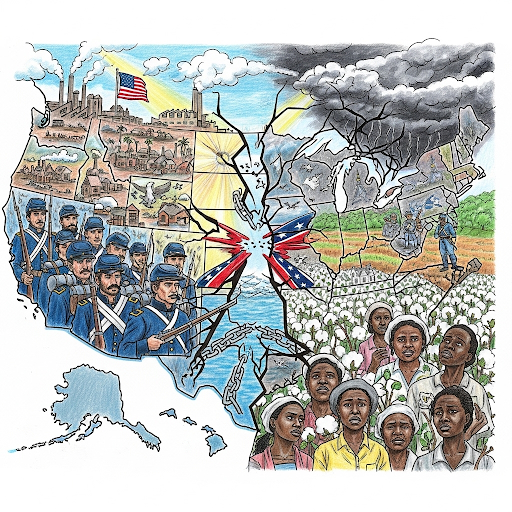The American Civil War began in 1861 after decades of growing sectional conflict over slavery, political power, and economic differences between North and South. The antebellum United States had been riven by disputes over the expansion of slavery into western territories, competing visions of federal authority and states' rights, and cultural and economic divergences that made political compromise increasingly fragile. A series of legislative and judicial flashpoints—the Missouri Compromise, the Compromise of 1850, the Kansas-Nebraska Act, and the Dred Scott decision—had intensified mistrust and violence, while the rise of the Republican Party and the election of Abraham Lincoln in 1860 convinced many Southern leaders that their political position and the future of slavery were imperiled, prompting the first wave of secessions that culminated in the formation of the Confederate States of America and open conflict at Fort Sumter in April 1861.
Lincoln's refusal to recognize secession and his determination to preserve the Union framed the initial political and military response to the crisis. After Fort Sumter fell to Confederate forces on April 12, 1861, Lincoln called for 75,000 volunteers to suppress the rebellion, prompting additional Southern states to secede and plunging a deeply divided nation into full-scale war. The conflict quickly transformed from a crisis of constitutional order into a total war that mobilized vast armies, civilian economies, and popular sentiments on both sides. Early expectations of a short, glorious campaign were replaced by the grim realization that modern, industrialized warfare would produce protracted friction, staggering casualties, and widespread social disruption.
Military technology, logistics, and strategic doctrine shaped the war's character and its devastation. The Civil War combined Napoleonic maneuvering with the destructive potential of modern rifled muskets, artillery, railroads, and telegraph communications, producing massed battles and lengthy sieges that inflicted horrendous losses. Major engagements such as Bull Run, Antietam, Gettysburg, and Vicksburg demonstrated both the bravery and the brutality of the armies, while disease, inadequate medical care, and the conditions of camp life claimed many lives in addition to battlefield deaths. Over the course of four years, casualties numbered in the millions when wounded, missing, and dead are combined, with estimates of soldier fatalities alone commonly cited at around 620,000 and some recent scholarship suggesting even higher totals; civilian communities across the South endured property destruction, economic collapse, and displacement as campaigns swept through their regions.
The Civil War's central moral and political issue—slavery—was transformed during the conflict from a question of Union preservation to a war that increasingly sought the emancipation of enslaved people as a strategic and moral objective. Lincoln's Emancipation Proclamation of 1863 reframed the war's aims, authorized the enlistment of African American soldiers, and linked Union victory to the dismantling of the slaveholding social order. Tens of thousands of Black men joined the Union ranks, and emancipation became both a liberating force and a profound social challenge: millions of newly freed people faced the daunting tasks of securing land, labor, legal rights, and civic recognition in a society long structured by racial hierarchy.
The war's conclusion in 1865 secured Union victory and legally ended slavery with the ratification of the Thirteenth Amendment, but it also launched a contentious and turbulent Reconstruction era in which the nation struggled to rebuild the devastated South, integrate millions of freed people into civic life, and redefine the meaning of citizenship and equality. Reconstruction produced significant achievements—constitutional amendments that extended citizenship and voting rights, federal efforts to protect civil liberties, and political participation by African Americans—but it also encountered fierce white resistance, economic retrenchment, and the eventual withdrawal of federal enforcement that allowed white supremacist structures to reassert control in many parts of the South. The long-term consequences included enduring racial inequalities, contested memories of the conflict, and a transformed federal-state relationship that shaped American governance going forward.
The Civil War's significance extends beyond its immediate human and constitutional consequences to its profound reshaping of the United States' economic, political, and social trajectory. The conflict accelerated industrialization in the North, devastated the Southern plantation economy, and marked the emergence of a stronger, more centralized federal government capable of directing national policy in wartime and peacetime. It altered demographic patterns through wartime migration and emancipation, influenced legal and political precedent about federal authority, and left an indelible legacy in American memory and culture through monuments, literature, and ongoing debates about race, rights, and national identity. The war's costs and consequences—measured in lives lost, families broken, and unresolved social wounds—remain central to understanding the United States' development and the continuing work of expanding the nation's founding promises to all its people.
